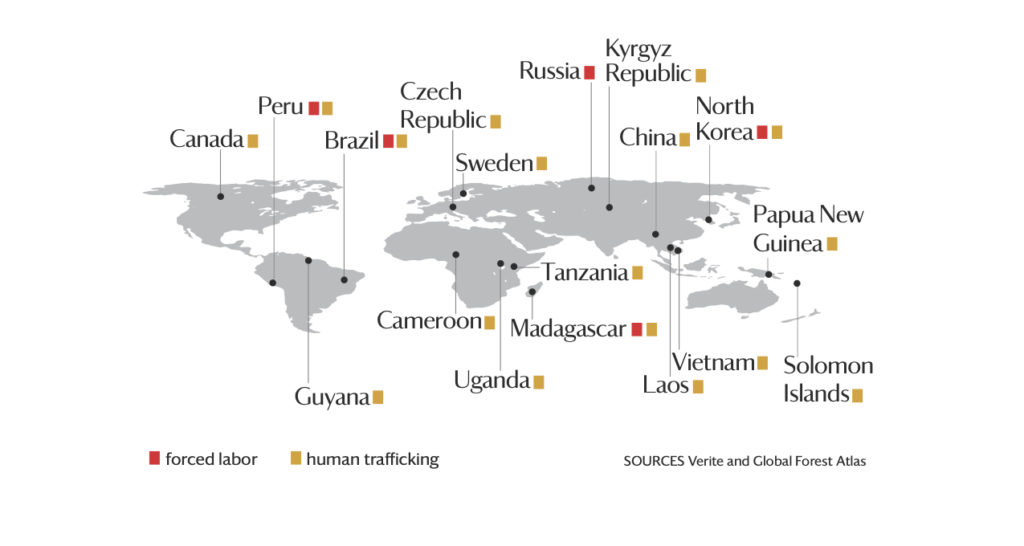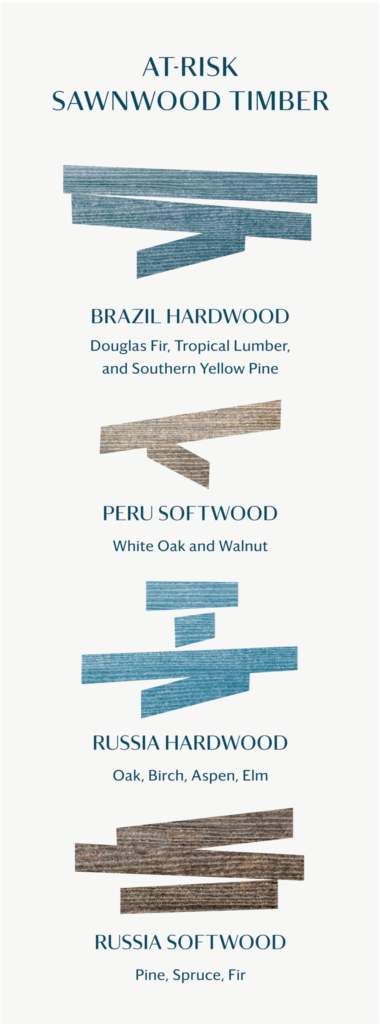Timber Assessment: Know the source, lessen your risk

“As a noble profession we choose to address global challenges while practicing even in our most modest local endeavors. Everything we build with has impact. Impact on the planet and impact on people. Our power and our duty is to be informed, to choose wisely, and to understand the true human impact of our choices. Ending forced labor means speaking with a collective and individual voice through our design choices to ensure fair and just treatment of all those who help us build the skylines of the future.”
Michael Green, AIBC, FRAIC, AIA
Principal, MGA | Michael Green Architecture
Timber is one of the most widely used construction materials in the world and is ranked as the fifth largest product (by value) at risk of forced labor imported into the U.S.1
The U.S. is the world’s second-largest importer of wood products valued at $48.7 billion,2 following China, and both import hard and soft woods from countries that have high rates of forced labor in their logging industries. Although China does not prohibit imports of illegally logged forestry products, the U.S. specifically amended the Lacey Act in 2008 to include the prohibition of illegal timber from entry.3 See, Lacey Act (16 U.S.C. §§ 3371–3378).
Given that an estimated 38% of wood products globally are being used for buildings and construction,4 an examination of timber’s provenance and the labor input is the responsibility of all decision-makers on design, construction, and manufacturing teams worldwide.
Workers in illegal timber operations are vulnerable to unsafe working conditions without regulations due to their remote locations, the presence of organized crime, government corruption, and a lack of oversight and regulation. Global timber forests are also valuable to countries and its workers. Considering up to 50% of global illegal logging depends on forced labor, which eliminates job and wealth creation that supports rural economies in many countries,5 it costs source nations up to $15 billion in lost annual revenue and more so, the human cost of generations of enslaved laborers who are deprived of their human dignity.6
Forced labor in the timber industry is widespread, especially in countries such as Brazil, Peru, and Russia, which are among the world’s major exporters of sawnwood. Diverse species of hard and soft woods are harvested from these countries, then enter the building materials supply chain, and are sent to projects across the globe. It is estimated that about three-quarters of harvested industrial roundwood is softwood,7 from gymnosperms such as pine, Douglas fir, spruce, and cedar. Softwoods are less expensive and faster-growing than hardwoods, and can be load-bearing for use in building components and furniture. Hardwoods are milled from angiosperm trees like oak, maple, teak, mahogany, and walnut, and are primarily used for finishes and furniture.

Below is a snapshot of the timber industries in these nations show how pervasive forced labor is:
Brazil: Supply chain investigations have shown that major retailer and construction groups in the U.S. source timber through intermediaries whose logging practices involve the use of slave labor, as defined by Brazilian law. Brazil’s valuable ipe remains in demand despite this human rights violation and even though environmentalists flagged it. Forced forestry labor is found in wood products and charcoal manufacturing as a steel input, as noted in this report.8 With initial, yet waning government oversight, 880 workers were liberated from 2011 to 2017 from modern slavery conditions while harvesting timber.9
Peru: A 2012 World Bank report indicated that 80% of Peru’s timber exports were tied to illegal logging operations.10 An estimated 33,000 people, mostly on lands of indigenous people in the Peruvian Amazon, are trafficked in the logging industry, which is also pervasive in the Brazilian Amazon. In addition to the exploitation of timber workers themselves, the sexual exploitation of children and teenagers is reported to be a major issue in and around the major logging operations within the country.11
Russia: An estimated 80% of all timber is illegally harvested and primarily located in eastern regions that contain old-growth forests. The timber workforce in this region is typically comprised of North Korean migrants sent on a state-sponsored labor-export scheme, who are isolated in remote, prison-like logging camps.12 A large portion of the timber produced under these modern slavery practices is exported to China, where it is blended with legally sourced material and exported worldwide, where it is routed to the U.S. including Lumber Liquidators, which was fined under the Lacey Act. Russian timber totals a quarter of all China forestry imports by volume.13
- Global Slavery Index 2018, Findings by Country – United States. Minderoo Foundation. 2018.
- Shifts in U.S. Merchandise Trade, U.S. International Trade Commission. 2018.
- Food, Conservation, and Energy Act of 2008 (Pub. L. 110-246).
- Ramage, Michael, et al. “The wood from the trees: The use of timber in construction.” Renewable and Sustainable Energy Reviews, Volume 68, Part 1. February 2017.
- Forced Labor in Forestry, Know the Chain, 2020.
- Sustaining Forests and Livelihoods in a Changing World, World Bank. January 29, 2013.
- Forest Products Annual Market Review, United Nations Economic Commission for Europe. 2007–2008.
- Campos, A. “Suppliers of Lowe’s in the US and Walmart in Brazil linked to slave labor in the Amazon,” Repórter Brasil. March 15, 2017.
- Timber Industry: Modern Slavery and the British Market, Repórter Brasil. 2018.
- Goncalves, Marilyne Pereira; Panjer, Melissa; Greenberg, Theodore S.; Magrath, William B. “Justice for Forests: Improving Criminal Justice Efforts to Combat Illegal Logging.” World Bank Study. Washington, DC, 2012.
- Strengthening Protections Against Trafficking in Persons in Federal and Corporate Supply Chains, Research on Risk in 43 Commodities Worldwide. Verité. 2017.
- Trafficking in Persons Report, U.S. Department of State. 2020.
- Russia. Environmental Investigation Agency.